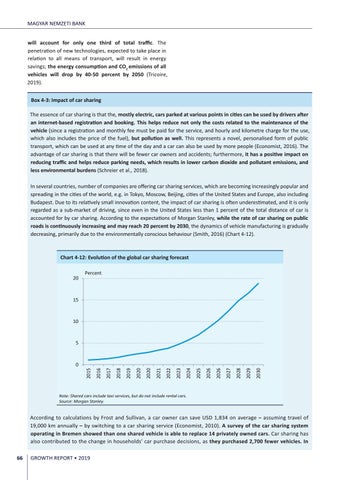MAGYAR NEMZETI BANK will account for only one third of total traffic. The penetration of new technologies, expected to take place in relation to all means of transport, will result in energy savings; the energy consumption and CO2 emissions of all vehicles will drop by 40-50 percent by 2050 (Tricoire, 2019). Box 4-3: Impact of car sharing The essence of car sharing is that the, mostly electric, cars parked at various points in cities can be used by drivers after an internet-based registration and booking. This helps reduce not only the costs related to the maintenance of the vehicle (since a registration and monthly fee must be paid for the service, and hourly and kilometre charge for the use, which also includes the price of the fuel), but pollution as well. This represents a novel, personalised form of public transport, which can be used at any time of the day and a car can also be used by more people (Economist, 2016). The advantage of car sharing is that there will be fewer car owners and accidents; furthermore, it has a positive impact on reducing traffic and helps reduce parking needs, which results in lower carbon dioxide and pollutant emissions, and less environmental burdens (Schreier et al., 2018). In several countries, number of companies are offering car sharing services, which are becoming increasingly popular and spreading in the cities of the world, e.g. in Tokyo, Moscow, Beijing, cities of the United States and Europe, also including Budapest. Due to its relatively small innovation content, the impact of car sharing is often underestimated, and it is only regarded as a sub-market of driving, since even in the United States less than 1 percent of the total distance of car is accounted for by car sharing. According to the expectations of Morgan Stanley, while the rate of car sharing on public roads is continuously increasing and may reach 20 percent by 2030, the dynamics of vehicle manufacturing is gradually decreasing, primarily due to the environmentally conscious behaviour (Smith, 2016) (Chart 4-12).
Chart 4-12: Evolution of the global car sharing forecast 20
Percent
15
10
5
2030
2029
2028
2027
2026
2026
2025
2024
2023
2022
2021
2020
2020
2019
2018
2017
2016
2015
0
Note: Shared cars include taxi services, but do not include rental cars. Source: Morgan Stanley.
According to calculations by Frost and Sullivan, a car owner can save USD 1,834 on average – assuming travel of 19,000 km annually – by switching to a car sharing service (Economist, 2010). A survey of the car sharing system operating in Bremen showed than one shared vehicle is able to replace 14 privately owned cars. Car sharing has also contributed to the change in households’ car purchase decisions, as they purchased 2,700 fewer vehicles. In 66
GROWTH REPORT • 2019
